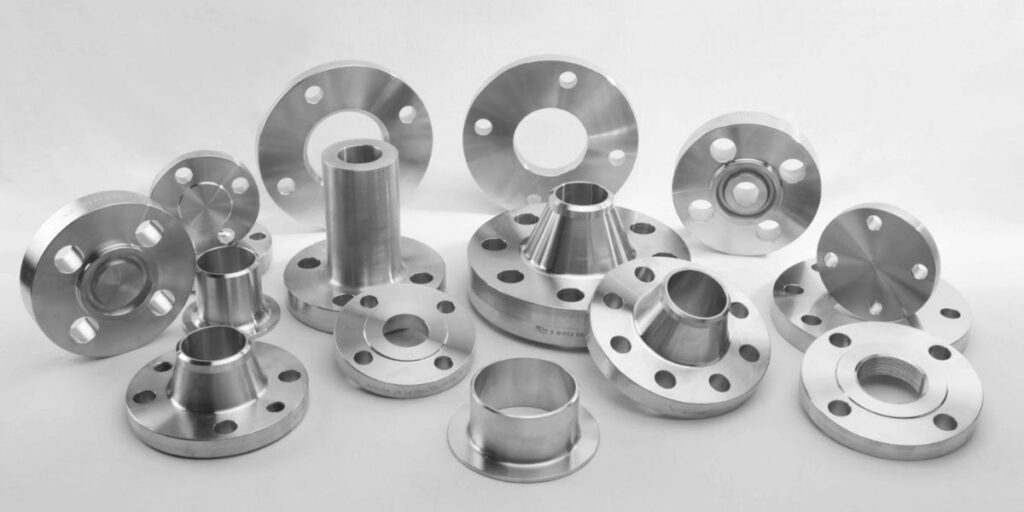Types of Flanges and their Applications

Table of Contents
Introduction
Flanges are an essential component in piping systems, connecting pipes, valves, pumps, and other equipment. They provide easy access for inspection, cleaning, and modification. Choosing the right flange type ensures safety, efficiency, and durability across industries such as oil & gas, petrochemicals, power generation, and shipbuilding.
This guide explains the different types of flanges, their features, and common applications.
Weld Neck Flange
Description: Designed with a long tapered hub that provides excellent stress distribution.
Applications
- Oil & gas refineries
- Chemical plants
- Power generation units
Slip-On Flange
Description: Slips over the pipe and is welded inside and outside for strength. Easier to install compared to weld neck flanges.
Applications
- Low-pressure piping systems
- Cooling water lines
- Firefighting pipelines
Blind Flange
Description: Used to close the end of a piping system or pressure vessel opening, allows easy reopening when needed.
Applications
- Pressure testing
- Temporary piping terminations
- Maintenance shut-offs
Socket Weld Flange
Description: Pipe is inserted into the socket end and fillet welded, offering a smooth bore for better flow.
Applications
- Small diameter high-pressure systems
- Hydraulic lines
- Chemical processing lines
Threaded Flange
Description: Connected by threads—no welding required. Good for low-pressure, non-critical use.
Applications
- Water supply systems
- Gas lines (low pressure)
- Temporary installations
Lap Joint Flange
Description: Works with a stub end, allows easy dismantling and alignment, cost-effective where frequent disassembly is needed.
Applications
- Food processing plants
- Pharmaceutical lines
- Low-pressure systems with frequent maintenance
Long Weld Neck Flange
Description: It is a type of weld neck flange with an extended neck that acts as a nozzle for pressure vessels, columns, or tanks.
Applications
- Pressure Vessels and Reactors
- Heat Exchangers and Boilers
- Petrochemical and Refinery Plants
Orifice Flange
Description: Includes provisions for flow measurement via orifice meters, typically supplied with meter taps.
Applications
- Flow measurement systems
- Oil & gas pipelines
- Chemical industry metering
Flange Materials we Manufacture
- Stainless Steel (SS 304, SS 316)
- Duplex Steel
- Super Duplex Steel
- Carbon Steel
- Alloy Steel
- Nickel Alloys
How to Choose the Right Flange
- Check pressure rating (ANSI / ASME standards).
- Consider temperature resistance.
- Match the right types of flanges type with piping requirements (flow, maintenance frequency).
- Ensure correct material for corrosion resistance and mechanical properties.
FAQ
What is the difference between weld neck and slip-on flange?
Weld neck flanges have a tapered hub suited for high pressure and temperature with better stress distribution, slip-on flanges are easier to install and are generally used for lower-pressure systems.
Are stainless steel flanges better for corrosive environments?
Yes, stainless steels like 316 offer superior corrosion resistance compared to carbon steel, choose duplex or nickel alloys for highly aggressive conditions.
Do flanges come with gaskets and bolts?
Typically flanges are sold separately from gaskets and fasteners, but many suppliers offer kits or can supply matched gaskets and bolt sets on request.
Conclusion
Flanges play a vital role in maintaining the integrity and efficiency of piping systems. From weld neck flanges for high-pressure use to slip-on flanges for easy installation, choosing the right type depends on your specific application.
At Shribhairav Forge, we manufacture and export high-quality flanges, forged fittings, pipe fittings, tube fittings, and fasteners that meet global standards. Contact us today to get a free quote or request our latest product catalogue.
